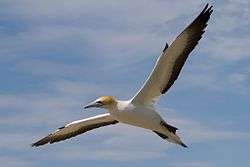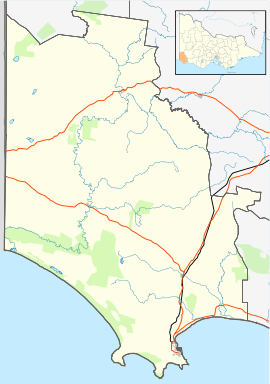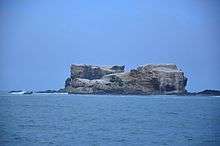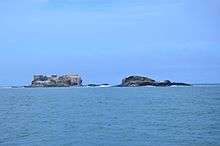Lawrence Rocks
The Lawrence Rocks are a group of two rocky islets, 6.8 ha and 1.5 ha in area, with an associated reef, 2.4 km south-east of Point Danger in western Victoria, Australia, and about 6 km south-east of the city of Portland.[3] Geologically, the group is formed from the remnants of an extinct volcano, with the islets composed of basalt and tuff.[4]
 The Lawrence Rocks are an important breeding site for Australasian gannets | |
 Lawrence Rocks | |
| Etymology | Captain Effingham Lawrence[1][2] |
|---|---|
| Geography | |
| Location | Bass Strait |
| Coordinates | 38°24′30″S 141°40′10″E |
| Area | 7 ha (17 acres)[3] |
| Length | 800 m (2,600 ft)[3] |
| Width | 50 m (160 ft)[3] |
| Highest elevation | 90 m (300 ft)[3] |
| Administration | |
Australia | |
| State | Victoria |
The islets were sighted by Lieutenant James Grant on 5 December 1800 from the survey brig HMS Lady Nelson and named[1] for Captain Effingham Lawrence,[2] one of the Elder Brethren of Trinity House.

Fauna
The rocks are protected as a nature reserve and are the site of a breeding colony of Australasian gannets, the overspill from which led to the establishment of a sister colony at Point Danger.[5] The group has been identified by BirdLife International as an Important Bird Area (IBA), because it supports over 10% of the world population of Australasian gannets, being used by over 6000 birds.[6] [7] Other birds recorded on the rocks, and likely to breed there, include little penguins, black-faced cormorants, crested terns, silver gulls, sooty oystercatchers and small numbers of Cape gannets. The rocks are also used as a haul-out site by Australian fur seals.[4] Seal hunting was conducted on the island in the 19th century.[8]

References
- Grant, James (1803). The narrative of a voyage of discovery, performed in His Majesty's vessel the Lady Nelson, of sixty tons burthen: with sliding keels, in the years 1800, 1801, and 1802, to New South Wales. Printed by C. Roworth for T. Egerton. pp. 71–72. ISBN 978-0-7243-0036-5. Retrieved 25 January 2012.
- Wall, Bruce (1967). "Lawrence, William Effingham (1781–1841)". Australian Dictionary of Biography. Melbourne University Press. ISSN 1833-7538. Retrieved 25 January 2012 – via National Centre of Biography, Australian National University.
- Pescott, T. W. (November 1980). "Seabird islands No 100, Lawrence Rocks, Victoria" (PDF). Corella. 4 (4): 107–109.
- BirdLife International. (2011). Important Bird Areas factsheet: Lawrence Rocks. Downloaded from http://www.birdlife.org on 04/08/2011.
- "Point Danger Australasian Gannet Breeding Colony". Portland Holidays. Archived from the original on 19 August 2006. Retrieved 28 February 2011.
- "IBA: Lawrence Rocks". Birdata. Birds Australia. Archived from the original on 6 July 2011. Retrieved 4 August 2011.
- http://islandarks.com.au/victoria-state-of-the-islands/
- Karen Townrow, An archaeological survey of sealing & whaling sites in Victoria, Heritage Victoria & Australian Heritage Commission, Melbourne, 1997, p.14.